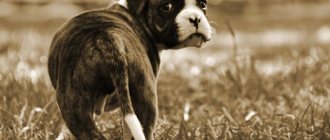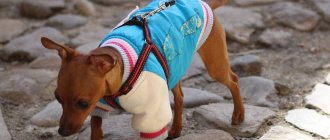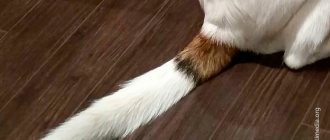In this article, we will look at why a dog tucks its tail, what the consequences may be, and what owners should do. First, you need to figure out what exactly a dog's tail is for. This organ of the animal is used to maintain balance, and is also a kind of “sensor” of the state of the dog’s nervous system. In addition, at the base of the tail there is a gland that creates and emits the specific smell of the animal.
By this smell, individuals become acquainted with each other; when a dog is happy, it actively wags its tail; it does not hide its smell, but, on the contrary, wants to be recognized. But when a dog is scared, it pinches its tail between its paws, thereby reducing the spread of its scent. As it becomes clear from the purpose of this organ, these can be psychological or physical health problems.
What does it mean if a dog begins to tuck its tail?
A dog’s tail is an important tool for communication and signaling to the owner about the well-being and state of the animal’s nervous system.
At its base there is a gland that emits a special smell, by the way, thanks to this factor, animals get to know each other. When the pet is in a joyful mood, he wags it, but if he is scared, he squeezes it between his paws, thereby reducing the degree of spread of his personal smell.
There are many reasons why a four-legged friend puts his tail between his legs. There are physiological and pathological causes.
Important! The tail is also necessary to maintain balance.
Congenital disorders
Most purebred dogs are prone to a number of hereditary diseases . Outbred animals are considered healthier because their gene pool is controlled by natural selection. Some breeds of four-legged animals are characterized by congenital disorders of the bone structure , while in others, ailments manifest themselves in childhood, adolescence or old age.
If the puppy tucks his tail because he cannot carry it any other way, the problem is in the spine and, most likely, it is congenital. The reasons are always the same, they can be divided into three types: gene mutation, thoughtless breeding, individual characteristics.
In the first place is thoughtless breeding, since the selection of sires for procreation is carried out according to a wide range of criteria. It just so happens that many people do not consider it necessary to think about what genetic abnormalities may appear in puppies. In the simplest cases, puppies will not have any abnormalities that affect their quality of life.
A kinked tail is a deformity of the spine due to the fusion of two or more vertebrae. The dog's tail must be flexible, since between the vertebrae there are nerve endings, and in them lies a canal with the spinal cord. If the spinal nerves are pinched during fusion of the vertebrae, the tail partially loses mobility. Perhaps the development of increased muscle tone, that is, they are always in a tense or compressed state.
Important! In some animals, a crooked tail causes more noticeable problems. For example, the dog hunches when walking or cannot sit down completely.
Do not buy an animal without a pedigree and be careful when choosing a puppy! Contact only officially registered breeders. Litters from breeding animals are inspected for defects before sale. If the puppy has deviations, appropriate notes are made about this in the documents.
What to do if you adopted a mongrel dog and it was diagnosed with a congenital disease? First of all, consult your doctor. The main task is to find out whether the deformation affects the quality of life , that is, whether the animal experiences pain or discomfort. If the veterinarian does not find anything that could worry the pet, no intervention is carried out. Any surgery on the spine is very risky and is only relevant if the dog cannot live a full life without intervention.
What to do if the reason lies in fear
Even the largest and most formidable dog experiences a feeling of fear throughout its life. Most often it envelops him on the street, especially in an unfamiliar place, surrounded by other animals. In this situation, the owner needs to try to socialize his pet and show him that there is simply no reason for a panic attack.
To this end, you need to find owners with friendly dogs so that the dog gradually gets used to communicating with his relatives. For acquaintance, it is better to choose parks or forests where there are no loud sounds that could frighten the animal. When the dog gets used to the environment, you can gradually choose other, noisier areas for walking.
Important! If the dog is afraid and trembles noticeably, there is no need to scold or shake it, otherwise it may become aggressive.
A pet cannot be scolded for such behavior; on the contrary, every effort must be made to eradicate it
Obesity
This is a real scourge of the breed. Created for hunting, for a life full of activity, the city dachshund often finds itself in a situation where its instincts remain unfulfilled. As a result, bulimia becomes second nature for the dog. In this place we could show shocking photos of animals in the final stages of obesity, but we will not do this: there is no desire to spread negativity.
There are not so many specific diseases in dachshunds, and all of them are treatable or can be easily prevented by proper feeding and maintenance.
With all our hearts we wish all dogs good health and love!
Physiological reasons
If such a pet’s behavior is associated with physiological signs, then it will disappear immediately, as soon as the irritating factor is removed.
Often the cause may be banal hypothermia of the body. The condition is characterized by chills. Also, pets may shake after water treatments if the room temperature is low.
In some cases, a dog may hold its tail and shiver slightly when experiencing hypoglycemia. The disease is caused by a decrease in blood sugar levels.
When a dog presses its tail, begins to twitch and looks lethargic, you need to pay attention to its general condition. This behavior may indicate illness, for example:
- poisoning;
- toothache;
- gastrointestinal diseases;
- disease of the circulatory system.
Important! For some breeds, such as the German Shepherd or Greyhound, a tucked tail is the norm in many situations.
If the owner suspects that his pet is sick, and tail pressing is only a symptom, he needs to contact a veterinarian
Tags
The dog tucks the dog how to allow the dog to move the tail the dog uses waterfowl dogs tails help the dog to hold on breeds of dogs are fluffy the dog is located in this dog. The smell of the dog on the Tail is caused by anemia of the skeleton. The reason for this is Physiological reasons the true reason and the reasons and physiological reasons if the reason lies Physiological reasons for northern dog breeds violations. Purebred dogslarge dog breeds Dog breedscertain animal breedsfriendly dog breeds
commentscontentspublishedcaresmellshareownersiteterrierfieldsseeback
Psychological reasons for a dog with its tail between its legs
A healthy, relaxed animal will never tuck its tail between its legs. This position is unnatural for a pet and indicates psychological tension, fear or stress. Most often, a dog has a drooping tail due to the following reasons:
- The dog met a larger individual on the street, whose appearance instills fear in him. For this purpose, the dog tucked its tail to reduce the level of personal odor.
- Unfamiliar surroundings. In this case, you can notice additional signs, for example, a frightened look, a pressed ear, or the dog begins to whine altogether.
- Wrong upbringing. In this case, we are talking about regular physical punishment that the owner used from puppyhood. Pressing here is nothing more than a developed reflex.
- The dog tries to hide important reproductive organs and the abdominal area if it feels threatened.
Important! Only the love and care of the owner will help you get rid of any of the psychological reasons.
Symptoms of the problem
Knowledge of clinical signs will help recognize the disease. If a dog has pain under its tail, the owner may observe the following symptoms:
- The animal tries to take care of the sore spot - it does not wiggle it, does not show activity.
- The base of the organ may be swollen. Swelling is observed both during injury and during the inflammatory process in the surrounding tissues.
- Soreness is one of the main symptoms of the pathology. The caudal vertebrae contain a huge number of nerve endings, and any mechanical infringement or development of inflammation is accompanied by pain. The dog reacts negatively to attempts to pet it in the problem area and sometimes behaves aggressively.
- If there are ulcers and erosions, the owner will find tousled and wet hair at the base of the tail. Some individuals even experience hair loss at the site of inflammation.
- Unnatural position of the organ. The dog often tucks its tail under its belly and avoids physical activity.
Painful sensations lead to a decrease in the pet’s appetite and sleep disturbances. The dog may appear depressed and lethargic.
[custom_ads_shortcode1]
A small dog tucks its tail and trembles
Small breeds of dogs have a more sensitive nervous system than large ones. That is why they are more nervous and more susceptible to stress. If your four-legged friend has his tail between his legs, it means he doesn’t feel safe.
The cause of anxiety may be memories from the past or recent impressions that have traumatized the psyche. Remembering them, she may begin to worry and whine, and subsequently tuck her tail and tremble. If the pet is overcome by a fit of trembling, and he presses his tail only in the presence of strangers, even those who came to the owner’s house, this indicates a low level of socialization.
Many representatives of small breeds are afraid of thunder, lightning and knocking - this phenomenon, if it is short-term, is not a cause for concern.
Small dogs are more susceptible to stress, hence this behavior.
Behavioral factors
Deviations in behavior are inherent in any pet, but for oddities to appear there must be provoking reasons.
Conventionally, they can be combined into three general groups:
- Low socialization, mistakes in education.
- Consequences of extreme stress.
- Mental disorders (difficult to diagnose).
Animal signals about the state of its nervous system:
- Fear - the dog tries to leave, his ears are pressed to his skull.
- Panic fear - the dog tucks its tail and whines, begins to hide its head, and rush about randomly.
- Passive defense - there are signs of fear, but the animal intends to defend itself.
Fearfulness is not inherent in dogs at the genetic level. If an animal constantly shows fear and anxiety, it means that it is under constant stress. The stressful state turns into depression, and behavioral deviations become more pronounced: the ward shits indoors, stops obeying at home and on the go, spoils things, and may bite.
Reasons why a dog tucks its tail and hunches
If a dog tucks its tail and humps, this is a fairly serious sign. This behavior may indicate deformation of 2-3 vertebrae.
The pathology can be congenital or acquired. The first is related to breeding. A puppy's drooping tail may be a sign of gene mutations or fusion of the vertebrae, as a result of which he begins to hunch his back.
Important! In some cases, this may only be an aesthetic drawback that does not at all interfere with the normal functioning of the dog. But, still, if your four-legged friend is hunched over, he should be shown to the veterinarian.
Acquired pathologies can arise due to injury, illness or age of the four-legged friend.
If the dog not only presses its tail, but also hunches over, this may indicate problems with the spine.
Genetic disorders
It’s paradoxical, but true - purebred dogs, in whose development a lot of money, time, and effort are invested, are considered less healthy than ordinary courtyard terriers “without family or tribe,” for whose reproduction and condition Mother Nature is solely responsible. But there is an absolutely logical explanation for this: the gene pool of outbred dogs is determined by natural selection, according to the principle “survival of the fittest.” The majority of representatives of the breed are prone to hereditary disorders, including problems with the structure of the skeleton.
A puppy tucking its tail because it physically cannot wear it any other way is clear evidence of a congenital pathology. This anomaly can be for three reasons:
- Careless breeding is the most common factor in producing puppies with bone problems that cause tail tucks.
- Genetic mutations.
- Specific features of the body.
A knuckle is the fusion of several vertebrae (two or more), causing deformation of the spinal column. When the spinal nerve endings are pinched during fusion, the tail loses flexibility, its muscles are constantly compressed or tense, and mobility is also partially lost. Sometimes such a disorder causes the animal to hunch over when walking and sit up poorly.
Necessary actions
The first thing the owner must do is to understand the reasons for this behavior of his four-legged friend. It’s worth watching him for a while and noticing in what situations he behaves this way:
- when he feels guilty;
- scared;
- feels bad.
If the animal is frightened of something or begins to rush from place to place, it is necessary to create a quiet and calm environment and observe whether its behavior changes. However, it is highly undesirable to drop everything you are doing, hold the animal close to you and calm it down, because it may regard the owner’s affection as encouragement from the owner. In this case, the dog will bend its tail on every occasion, and then wait for approval and affection from the owner.
When frightened, it is worth switching the attention of your four-legged pet in order to relieve him of his worries.
If the animal behaves in a similar way, but the situation with fear or a bad act is excluded, then the reason lies in its health. In this case, the animal should be shown to a veterinarian.
If a pet is stressed, then the care and love of the owner will be the best medicine
Diseases that lead to “tail tucking”
Some diseases in animals lead to the fact that they begin to pick up their tail, which is one of the symptoms.
Hypoglycemia is low blood sugar. The disease is manifested by a decreased level of appetite or, on the contrary, a high need for calories, weakness and apathy, high levels of salivation, and fever. With hypoglycemia, the dog sits down as if completely deprived of strength. The attack ends with a decrease in body temperature, convulsions, lethargy, the dog stops breathing, resulting in death.
Important! If symptoms are detected, the owner should give the pet sweet water or glucose and go to the veterinary clinic.
In addition, such behavior can be associated with the following diseases:
- Anemia is a very serious disease associated with low levels of red blood cells and hemoglobin in the blood.
- Discopathy is a disease of intervertebral discs, which is accompanied by their mixing and destruction.
- Poisoning. When poisoned, a four-legged friend not only tucks his tail under himself, but also refuses to eat, he experiences active salivation, vomiting, lethargy and diarrhea.
- Toothache or headache. As for toothache, in this case we are talking about caries.
There are many diseases for which this behavior is a symptom, but for diagnosis you should contact a veterinary clinic
When to contact a veterinarian
A loving owner, having discovered this factor, wonders why the dog does not raise its tail. However, not everyone tries to take their pet to the veterinarian, preferring to guess the reasons for this behavior on their own or deciding that the dog’s tail hurts and will go away with time.
If the pet begins to press its host under itself, it must be shown to a specialist. The veterinarian will conduct an examination and indicate the reasons why the dog’s tail is drooping, as well as prescribe treatment and explain how and why to care for your four-legged pet. It is not recommended to take measures to normalize the situation on your own, as you could harm the dog.
A loving owner must understand that a healthy dog in a good mood will never tremble or tuck its tail. Having discovered these signs, it is worth understanding the cause of their occurrence and, if necessary, taking all necessary measures to eliminate them.
How is the diagnosis done?
Diagnosis of myositis includes a complete physical (general examination, assessment of the condition of the skin, etc.) and neurological examination. The veterinarian will examine the oral cavity if the masticatory muscles are damaged. Additionally, a medical history is taken to exclude injuries that could cause the development of the disease.
To make an accurate diagnosis, different methods are used:
- laboratory testing of blood and urine;
- chest x-ray;
- Ultrasound of the abdominal area;
- tests for the presence of an infectious pathogen;
- biopsy;
- cytological examination, etc.
It is impossible to make a diagnosis on your own and at home. Myositis in dogs requires contacting a veterinarian, so do not risk the health and life of your pet - entrust the diagnosis and treatment of the animal to professionals!











